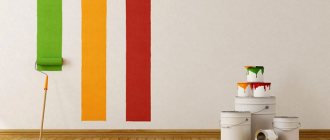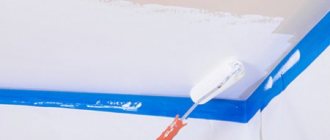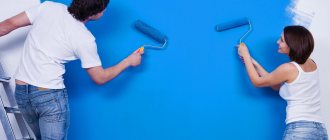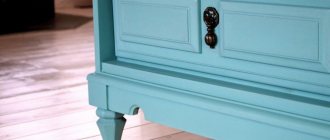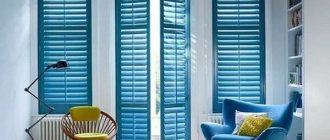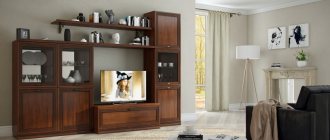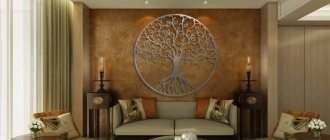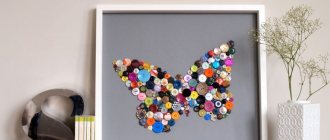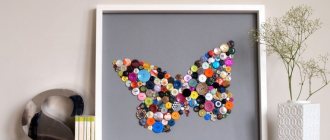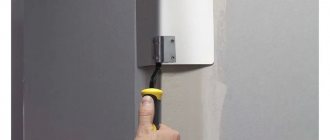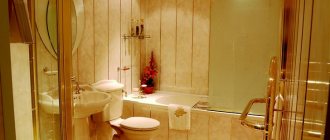Decorating your own home is a very important issue in the life of any person. There are many options for creating a unique interior. One type of finishing is painting walls with water-based paint. We'll figure out how to prepare walls for painting, how to level the surface, and also how to properly paint walls with water-based paint with a roller without streaks.
Using water-based paint, you can create a unique interior in your apartment yourself Source ognebiozashita.kiev.ua
Preparatory work
The final result depends on the quality of wall preparation. The surface to be painted must be cleaned of old materials. This could be whitewash, wallpaper or oil paint. Only after this should the wall be perfectly leveled.
Removing old whitewash and paint
If there was previously a thick layer of whitewash, then you need to make a large number of shallow cuts on the treated area, and then thoroughly wet the entire surface with warm water. In this state, the wall should stand for about half an hour, after which it is necessary to wet the coating again and wait until it is completely wet. After the procedures, the whitewash can be easily removed with a spatula. Then the walls are washed with a regular sponge. It is not necessary to apply incisions to thin layers.
Old water-based paint can be removed in the same way. Much more difficulties arise when removing oil paints and nitro enamels. Sometimes a construction hair dryer serves as an assistant, with the help of which the painted surface is heated, and then the used material is scraped off with a spatula.
Before painting, the walls are cleaned of old coating Source vestnikao.ru
Using a hair dryer is ineffective when removing old materials. It will be a waste of time to use this method of getting rid of the old coating. There is a technology for washing with chemicals. This procedure is quite unpleasant and can harm the respiratory tract. To avoid poisoning, you need to open the doors and windows in the room to create a draft, and if possible use a respirator and rubber gloves. Apply the solvent to the coating with a rag, wait the time specified in the instructions, and wash off the old paint. The process is repeated several times until the base is completely clean.
There are also mechanical ways to remove old coatings. The simplest method is sanding walls manually or using a grinder. You can use a drill with various attachments.
Grinding attachment for drill Source zaggo.ru
Puttying and priming
As already mentioned, the entire area to be painted with water-based paint must be brought to perfect smoothness; cracks and roughness are not allowed. To eliminate roughness, the walls are puttied.
To identify weak points, the suspected areas are carefully inspected, tapped with a hammer, and doubtful areas with cracks are picked out with a spatula to remove small fragments from them. The resulting large potholes are plastered with a solution based on a cement-sand or gypsum mixture. After drying, proceed to direct leveling. Step by step it will look like this:
- Padding.
- Applying starting putty.
- Final putty.
- Grinding (sanding the surface) with a grinding machine, a special mesh or sandpaper.
The primer serves for better adhesion. In addition, the procedure helps reduce the consumption of other materials, and the paint will lie evenly. Drying time for the primer is approximately 6 hours. It is usually indicated in the instructions for the material. You can also recognize the complete drying of the walls after applying the primer by touch.
Advice! The primer is applied with a roller. It is preferable to prime in two layers. The second layer can be applied after the previous one has completely dried.
Leveling walls for painting with putty Source couo.ru
See also: Catalog of companies that specialize in finishing materials and related work
Types and characteristics of water-based paint
Among the varieties of this type of finishing it is worth highlighting:
- acrylic;
- silicone;
- silicate;
- polyvinyl acetate.
Water-based mixtures on the walls quickly become ready. This usually takes about a day. Paints dry in 20 hours, sometimes in less than 10, in some cases in more than 48 hours. Compositions that meet GOST do not emit a pungent odor, are easily amenable to the movements of tools, acquire any shades and maintain an intact surface for a long time. The viscosity of solutions is adjusted depending on the application method: with a brush, materials with an indicator of 40-45 units are used, and with a spray gun - 20-25. The paint is applied in one or several layers, and an average of 250 grams is used per 1 m².
Polyvinyl acetate solutions are considered the “weakest” option. Although they are cheap and are better suited than others for wooden and porous coatings, they do not tolerate moisture well and are inferior to other varieties in terms of durability. Acrylic mixtures are an expensive and high-quality version of water-based paints; silicone compositions claim to be the “golden mean”, but silicate ones, if properly selected, will be an ideal solution in rooms with normal conditions.
Acrylic water-based paint
This is what is used most often. Solutions are made from acrylic resins with additives as inclusions. For example, a latex additive allows paint to be used in areas exposed to water. Painted surfaces can be washed without fear that the quality of the coating will deteriorate.
Acrylic water-based mixtures are also applied to walls with a difference of up to 1 mm and randomly located roughness. As for surface types, acrylic options are the most versatile and are compatible with plastic, wood, concrete and even glass. Among all types of water-based compositions, acrylic is best suited for metal coatings, not least because it has anti-corrosion properties. It also dries better than others. Just a few hours are enough to begin subsequent manipulations. Due to the high price of conventional mixtures, manufacturers also produce paints with acrylic copolymers.
Silicone water-based paint
The material is used in damp rooms, as well as in rooms where moisture forms. The listed uses are suitable for these solutions due to the fact that the silicone base gives them high vapor permeability. Mold and mildew do not grow on surfaces painted with silicone paint. The reappearance of these microorganisms will also not threaten walls and ceilings. At the same time, in terms of resistance to water, the mixtures are inferior to acrylic ones.
Among the positive qualities are plasticity, strength and ease of use. The cost of silicone mixtures is difficult to count as an advantage, but the price-quality ratio has contributed to its spread on the market. Water-based paint with silicone-based components hides cracks and depressions up to 2 mm in diameter. Silicone solutions are considered a cross between acrylic and silicate.
Silicate water-based paint
The emulsion is made from liquid glass and coloring additives. Raw materials have low cost and long service life. Silicate paint withstands temperature changes well. Mixtures that are resistant to natural phenomena can last 2 decades without updating. There are modifications for sale for interior and exterior decoration, as well as universal solutions - they are classified depending on the severity of their properties.
The coating painted with a silicate mixture absorbs air in which there is excess moisture. In rooms that are too dry, the surface will release moisture. With all this, raw materials cannot be compared with silicone, because the latter is used in places where the walls and ceiling are constantly exposed to moist air. The glass-based variety is suitable for the facades of houses near which there are high groundwater levels.
Wall painting
Water-based paint is rightfully considered an environmentally friendly material for finishing apartments and houses. A large assortment of colors allows you to choose the right color to create any interior. There are many application methods. Using textured rollers allows you to even change the texture. The design options cannot be compared with anything. The basic rule when painting walls with water-based emulsion is compliance with all proven technologies and application sequence.
To ensure that the painting process does not take too long, and the result will only please you, you need to make sure in advance that you have good construction equipment on hand.
In order to successfully paint walls with water-based paint, you need good tools and materials:
- roller with handle;
- brush;
- bath or tray;
- electric drill with attachment;
- film for covering the floor to protect against splashing;
- dye;
- color.
Painting walls with a roller is one of the most common methods of applying water-based emulsion.
In the bath, the roller is evenly saturated with paint Source stpulscen.ru
Preparing for work
The paints that come from retail outlets have a thick consistency. To obtain the desired degree of viscosity, add a little water. Mix the composition with a drill equipped with a mixing attachment. There is no need to dilute the paint with water to create a textured surface.
After mixing, the paint is given the desired shade. For this purpose, various colors are available for sale. You can choose the tone yourself by combining colors in different proportions. In large retail outlets, computer shade selection is carried out using special installations. When preparing it yourself, remember that the color changes slightly as it dries.
The paint is diluted for the entire area at once, so as not to have to worry about tinting later; it will be difficult to manually select the same tone.
Application of water-based paint
Typically a roller, sponge or paint brush is used for this purpose. The texture depends on which tool is chosen.
Painting walls with water-based paint using a roller is the fastest and most convenient way. The second advantage is that the paint is applied evenly with a roller. The layers are thin.
Painting a wall with a roller and water-based paint Source sdelai-lestnicu.ru
Advantages and disadvantages
Water-based solutions pose no threat to human health or nature. None of the known types of paint contain toxic or other hazardous substances. The raw materials do not emit a sharp unpleasant odor that consumers feel when painting with other types of solutions.
As soon as the water evaporates, the craftsmen begin the next stage of work. Manufacturers promise very fast drying, but in reality you have to wait even a day or more. Still, it's relatively fast.
Compositions based on aqueous emulsion are given any color without exception. A construction mixer and additional amounts of pigments are used for this. Even an inexperienced person can achieve pure colors. With all this, a decent palette of ready-made solutions will immediately open to the buyer.
The material is washed with water; no solvents are used. Hands and tools will be clean in less than a minute.
Water-based solutions also have disadvantages. It is worth highlighting 4 key disadvantages:
- poorly suited for glossy and metal surfaces;
- water-based compositions are easier to counterfeit;
- apply easily, but not as evenly as thicker paints;
- they are often overused.
Technology
Work starts from the top. This start will prevent streaking and ensure uniformity. Following the recommendations of professionals, the entire area is mentally divided into squares. Their number depends on the size of the roller: one square is equal to five times the width of the nozzle.
The working area is additionally divided into 5 verticals, the first line is skipped and the second strip is painted immediately. Then they skip the third vertical, moving directly to the fourth. Finish at the fifth line. Then you can move on to the remaining runs: the first and third.
The second layer of paint is applied in the reverse order: start with the third line, then paint the first, fourth, fifth. The finishing line should be the second stripe.
After completing the painting work, the drying process begins. The duration of setting depends on the temperature and humidity in the room. To speed things up, you can open a window. It is strictly forbidden to do this in winter.
If the weather permits, you can open the window for ventilation Source squarespace.com
Subtleties of choosing what is better to paint indoors
Experts recommend buying paint that is similar in composition to plaster for interior decoration. For example, if brick walls are plastered with acrylic compound, then they are painted with acrylic enamel. These enamels are also suitable for textured plaster such as bark beetle.
If there is a problem with how to paint cement plaster, then lime will do.
Note! If the cement base is covered with finishing putty, then any paint can be used.
Gypsum plaster also requires the application of putty or careful priming to ensure good adhesion to the paint. For painting, use water-based compounds.
Wall decoration with gypsum stone is now popular. To tint it, you can use acrylic paint.
Creating textured surfaces
Sometimes water-based compositions are used to obtain a textured surface. To do this, take a thick mixture that is not diluted. It is applied to the walls with a stiff bristle roller, lint-free roller or foam sponge. The rigid structure of the pile allows you to fill existing pores on the wall. The second step is to grout the protruding parts with a lint-free roller or foam rubber. The use of solutions of other shades is allowed.
Textured painting Source eurobud-fasad.com
How to choose correctly
Sellers may not differentiate between water-based and water-based paints. This is the first difficulty, and it can be solved simply: the packaging must contain the inscription “water-based”.
Surfaces in apartments get dirty quickly, especially with greasy stains, so you should choose washable options. Of course, if this factor does not become limiting. The paint packaging should be checked for compliance with GOST. There are not enough marks on the packaging; you need to ask for a certificate. The process of making water-based compositions itself is not very difficult, so fakes come across more often than in the case of other paints. Complex equipment and specific substances that are difficult to obtain are not used in production. This is good for the price, but in terms of quality assurance you will have to be vigilant. In addition to the listed criteria, it is worth paying attention to the specifics of consumption and the intended purpose - for interior or exterior work.
Application Features
Knowing some secrets will help you paint walls with water-based paint yourself:
- When preparing the composition, you need to immediately calculate the amount that will be sufficient for the entire room. Otherwise, finding the same shade will not be easy
- The walls are painted in one go. This is the main condition for quality finishing.
- To paint corners and small details you will need a small brush, no more than 5 cm wide.
- Excess paint is immediately wiped off on the edge of the pallet, otherwise it will leave streaks on the walls.
- The mixture is applied to small areas from top to bottom.
- Before starting work, the baseboards, window sills, and ceiling (if it is already painted) are insulated with masking tape. Masking tape is also used to mark boundaries. It is removed immediately after painting the area. Once the paint has hardened on the tape, it is almost impossible to remove it without damaging the wall.
To get a good result, you need to have a creative approach to the process, correctly distribute your forces and show imagination.
Work equipment
You won't need too many tools, here's the full list:
- Pallet. It is desirable that it be equipped with a special ribbed platform, which is used to uniformly impregnate the roller and remove excess water emulsion.
- Roller. The best option is a nozzle with artificial fur or medium-length bristles. Professionals recommend using foam rubber and velor rollers in other cases.
- Telescopic handle. You may need it to work without climbing on a stool or stepladder.
- Masking tape. It will be very useful if the ceiling is already painted and needs to be protected from accidental brushstrokes. You can also use it to create simple and complex geometric patterns or to delimit areas that you plan to paint in different shades.
- Brushes. Wide (about 8 cm) and flat - for painting corners and joints of walls and ceilings, and a narrower brush, which is convenient for getting around sockets and painting hard-to-reach places.
- A special whisk or corresponding attachment for a drill. They are needed for mixing paint.
A good painting tool will make the job much easier.
Briefly about the main thing
You can independently finish walls with water-based paint if you follow known rules and developed technologies. Important emphasis is placed on the choice of tools. It is necessary to calculate the area of the walls to determine the amount of material. Color and tinting can be selected at retail outlets on the computer. However, you can do this yourself manually. It should be remembered that the tone changes as the paint dries.
High-quality preparation of the surface to be painted is 50% success. To avoid streaks and gaps, the work is carried out in stages in several layers. Each new layer is applied only after the previous one has dried. Speed of work is also important due to the rapid setting of materials.
If all conditions are met, a good result is guaranteed.
How to choose a color
Assortment of tinting agents:
- color with a metallic or pearlescent sheen;
- universal pastes for enamels;
- concentrates with a liquid consistency;
- pigment pastes.
Universal coloring pastes are suitable for epoxy, nitrocellulose and polyurethane enamels. Pigment is used with wood and lumber.
For water-based emulsions, the maximum content of coloring pastes and colorants is about 20%. At the highest rate, the saturation will be maximum, and the treated coating will not suffer from chemical exposure.
The pigments themselves for tinting are of natural or inorganic origin. The first group has a brighter and deeper color, but compositions with them do not have high light resistance. The surface will be unprotected from exposure to alkalis. Natural colors include umber, lapis lazuli, ocher, manganese, etc. Artificial dyes like carotene or rhodopsin give the mixture high light fastness, but leave much fewer color options.
Before purchasing, you should find out what the final result will be, and for this they use special catalogs. Exceeding the permissible concentration will lead to a change in the properties of the paint, and if the content is too low, the raw material will have to be stirred frequently.
Using masking tape
The vertical surface of the beam had to be painted the color of the walls, and the horizontal surface the color of the stretch ceiling, white. When painting with a roller, the paint got onto the adjacent surface.
It is difficult to obtain a high-quality surface of the beam corners using a brush. So I had to use masking tape.
Adjacent surfaces that should not be touched by paint are sealed with strips of adhesive tape. Masking tape differs from the usual transparent tape in that it can be easily peeled off if necessary and does not leave marks on the surface to which it was glued.
You need to remove the masking tape an hour after finishing painting, until the paint has completely hardened, otherwise equal edges may remain. As you can see, the resulting corners have an even line between paints of different colors.
